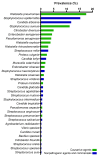Microbial Landscape and Antibiotic-Susceptibility Profiles of Microorganisms in Patients with Bacterial Pneumonia: A Comparative Cross-Sectional Study of COVID-19 and Non-COVID-19 Cases in Aktobe, Kazakhstan
- PMID: 37627717
- PMCID: PMC10451206
- DOI: 10.3390/antibiotics12081297
Microbial Landscape and Antibiotic-Susceptibility Profiles of Microorganisms in Patients with Bacterial Pneumonia: A Comparative Cross-Sectional Study of COVID-19 and Non-COVID-19 Cases in Aktobe, Kazakhstan
Abstract
This cross-sectional study investigated the microbial landscape and antibiotic-resistance patterns in patients with bacterial pneumonia, with a focus on the impact of COVID-19. Sputum samples from individuals with bacterial pneumonia, including coronavirus disease 2019-positive polymerase chain reaction (COVID-19-PCR+), COVID-19-PCR- and non-COVID-19 patients, were analyzed. Surprisingly, the classic etiological factor of bacterial pneumonia, Streptococcus pneumoniae, was rarely isolated from the sputum samples. Furthermore, the frequency of multidrug-resistant pathogens was found to be higher in non-COVID-19 patients, highlighting the potential impact of the pandemic on antimicrobial resistance. Strains obtained from COVID-19-PCR+ patients exhibited significant resistance to commonly used antibiotics, including fluoroquinolones and cephalosporins. Notably, the ESKAPE pathogens, Staphylococcus aureus, Klebsiella pneumoniae, Pseudomonas aeruginosa, Enterobacter cloacae, and Enterobacter aerogenes, were identified among the isolated microorganisms. Our findings underscore the urgent need for infection control measures and responsible antibiotic use in healthcare settings, as well as the importance of enhancing pneumonia diagnostics and implementing standardized laboratory protocols.
Keywords: COVID-19; antibiotics; antimicrobial resistance; bacterial; etiology; pathogens; pneumonia; sputum.
Conflict of interest statement
The authors declare no conflict of interest.
Figures



Similar articles
-
Distribution and Drug Resistance of Bacterial Pathogens Associated with Lower Respiratory Tract Infection in Children and the Effect of COVID-19 on the Distribution of Pathogens.Can J Infect Dis Med Microbiol. 2022 Mar 29;2022:1181283. doi: 10.1155/2022/1181283. eCollection 2022. Can J Infect Dis Med Microbiol. 2022. PMID: 35368516 Free PMC article.
-
Pneumonia in hospitalized neurologic patients: trends in pathogen distribution and antibiotic susceptibility.Antimicrob Resist Infect Control. 2019 Feb 1;8:25. doi: 10.1186/s13756-019-0475-9. eCollection 2019. Antimicrob Resist Infect Control. 2019. PMID: 30733859 Free PMC article.
-
The Microbial Profile and Resistance Pattern of Pathogens Isolated From Long COVID Pneumonia Patients and Their Correlation to Clinical Outcome: Our Experience From a Tertiary Care Hospital.Cureus. 2022 Mar 30;14(3):e23644. doi: 10.7759/cureus.23644. eCollection 2022 Mar. Cureus. 2022. PMID: 35505733 Free PMC article.
-
An overview of resistance profiles ESKAPE pathogens from 2010-2015 in a tertiary respiratory center in Romania.Rom J Morphol Embryol. 2017;58(3):909-922. Rom J Morphol Embryol. 2017. PMID: 29250670 Review.
-
Sulopenem: An Intravenous and Oral Penem for the Treatment of Urinary Tract Infections Due to Multidrug-Resistant Bacteria.Drugs. 2022 Apr;82(5):533-557. doi: 10.1007/s40265-022-01688-1. Epub 2022 Mar 16. Drugs. 2022. PMID: 35294769 Review.
Cited by
-
Targeting FMN, TPP, SAM-I, and glmS Riboswitches with Chimeric Antisense Oligonucleotides for Completely Rational Antibacterial Drug Development.Antibiotics (Basel). 2023 Nov 8;12(11):1607. doi: 10.3390/antibiotics12111607. Antibiotics (Basel). 2023. PMID: 37998809 Free PMC article. Review.
-
Bibliometric Analysis of Global Research Output on Antimicrobial Resistance among Pneumonia Pathogens (2013-2023).Antibiotics (Basel). 2023 Sep 6;12(9):1411. doi: 10.3390/antibiotics12091411. Antibiotics (Basel). 2023. PMID: 37760709 Free PMC article.
-
Antimicrobial resistance burden pre and post-COVID-19 pandemic with mapping the multidrug resistance in Egypt: a comparative cross-sectional study.Sci Rep. 2024 Mar 26;14(1):7176. doi: 10.1038/s41598-024-56254-4. Sci Rep. 2024. PMID: 38531847 Free PMC article.
References
-
- Troeger C., Blacker B.F., Khalil I.A., Rao P.C., Cao S.J., Zimsen S.R.M., Albertson S., Stanaway J.D., Deshpande A., Farag T., et al. Estimates of the global, regional, and national morbidity, mortality, and aetiologies of lower respiratory infections in 195 countries, 1990–2016: A systematic analysis for the Global Burden of Disease Study 2016. Lancet Infect. Dis. 2018;18:1191–1210. doi: 10.1016/S1473-3099(18)30310-4. - DOI - PMC - PubMed
-
- Dagenais G.R., Leong D.P., Rangarajan S., Lanas F., Lopez-Jaramillo P., Gupta R., Diaz R., Avezum A., Oliveira G.B.F., Wielgosz A., et al. Variations in common diseases, hospital admissions, and deaths in middle-aged adults in 21 countries from five continents (PURE): A prospective cohort study. Lancet. 2020;395:785–794. doi: 10.1016/S0140-6736(19)32007-0. - DOI - PubMed
-
- Disease G.B.D., Injury I., Prevalence C. Global, regional, and national incidence, prevalence, and years lived with disability for 354 diseases and injuries for 195 countries and territories, 1990–2017: A systematic analysis for the Global Burden of Disease Study 2017. Lancet. 2018;392:1789–1858. doi: 10.1016/S0140-6736(18)32279-7. - DOI - PMC - PubMed
Grants and funding
LinkOut - more resources
Full Text Sources

